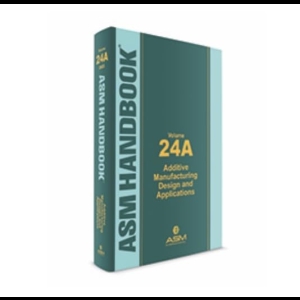ASM Handbook, Volume 24A provides a comprehensive review of additive manufacturing (AM) design fundamentals and applications. The primary focus of the Volume is on metallic systems with limited emphasis on polymers and ceramics where applicable.
- The first five divisions provide an in-depth review of each of the key aspects of the entire AM value chain.
- The materials/process development division discusses AM process-structure-property relationships, process optimization and defects, and material/process modeling.
- The design principles division includes coverage of design rules, part consolidation and assemblies, and simulation-driven design.
- In the data management division, data analytics, data security, and data sharing through a common data model are discussed.
- Next, the mechanical property division section includes discussion on fatigue, tensile, hardness, and other property testing.
- The AM non-destructive evaluation (NDE) division discusses surface and geometrical characterization, ultrasonic testing, radiography, computed tomography, and resonant ultrasound spectroscopy. Included in the AM in-situ process control and monitoring division are articles on machine learning for anomaly detection, in-process thermography, laser powder-bed fusion process control, and in-situ x-ray imaging.
- The applications division reviews key sectors that are embracing and adopting AM technologies. The market sectors are aviation, space flight, medical, automotive, oil and gas, construction, energy, and electronics.
- The last two divisions cover AM standards, qualification, and certification, as well as environmental, economic, and business concerns.
Volume 24A is a companion to ASM Handbook, Volume 24: Additive Manufacturing Processes, published in 2020.
Contents
MATERIALS/PROCESS DEVELOPMENT
Introduction to Materials and Processes for Additive Manufacturing/Alloy Design and Material Selection
Process-Structure Relationships in Fusion Metals Additive Manufacturing
Structure-Property Relationships in Additive Manufacturing
Process Defects in Metal Additive Manufacturing
Process Optimization
Material Modeling in Additive Manufacturing
Part-Scale Process Modeling for Metal Additive Manufacturing
Aluminum Alloy Design for Additive Manufacturing
DESIGN PRINCIPLES
Introduction to Design for Additive Manufacturing
Design Rules
Part Consolidation and Assemblies
Simulation-Driven Design and the Role of Optimization in Design for Additive Manufacturing
Architected Cellular Materials
DATA MANAGEMENT AND DIGITAL THREAD
FAIR Additive Manufacturing Data Management Principles
Data Analytics and Machine Learning in Metal Additive Manufacturing—Challenges, Segmentations, and Applications
Data Formats in Additive Manufacturing
Additive Manufacturing Data and Metadata Acquisition—General Practice
Data Security in Additive Manufacturing
Evolution of Data Management and Common Data Models for Additive Manufacturing
History, Development, and Potential Benefits of the Additive Manufacturing Common Data Dictionary
Additive Manufacturing Data Integration and Recommended Practice
MECHANICAL PROPERTY CHARACTERIZATION
Effects of Process-Induced Defects on Fatigue Properties of Laser Powder-Bed Fusion Metallic Materials
Tensile Properties
Creep Performance of Additively Manufactured Alloys
Nanoindentation Hardness, Strain Rate Sensitivity, and Corrosion Response of Additively Manufactured Metals
Novel Test Methods
NONDESTRUCTIVE TESTING AND EVALUATION IN ADDITIVE MANUFACTURING
Non-Destructive Evaluation in Additive Manufacturing—A Review
Surface and Geometrical Characterization and Measurements in Additive Manufacturing
Review of Ultrasonic Testing for Metallic Additively Manufactured Parts
X-ray—Radiography and Computed Tomography in Additive Manufacturing
Resonant Ultrasound Spectroscopy Testing Methods in Additive Manufacturing
IN SITU PROCESS CONTROL AND MONITORING IN ADDITIVE MANUFACTURING
In Situ Process Control and Monitoring in Additive Manufacturing—An Overview
Physics-based Feedforward Control of Metal Additive Manufacturing
Application of Machine Learning to Monitor Metal Powder-Bed Fusion Additive Manufacturing Processes
In-Process Thermography of Metal Additive Manufacturing Processes
Methodologies and Implementation of Laser Powder-Bed Fusion Process Control
In Situ X-Ray Imaging of Metal Additive Manufacturing Processes
Online Monitoring and Control of Polymer Additive Manufacturing Processes
APPLICATIONS OF ADDITIVE MANUFACTURING
Additive Manufacturing Applications in Aviation
Metal Additive Manufacturing in the Space Industry
Medical Applications of Additive Manufacturing
Laser Powder-Bed Fusion Additive Manufacturing of Structural Automotive Components
Additive Manufacturing in the Oil and Gas Industry
Large-scale Additive Manufacturing for Automated Construction—An Overview
Additive Manufacturing in the Nuclear and Wind Energy Sectors
Additive Manufacturing in Electronics and Functional Devices
STANDARDS, QUALIFICATION, AND CERTIFICATION IN ADDITIVE MANUFACTURING
Additive Manufacturing Terminologies
Standardization and the Use of Standards in Additive Manufacturing
Qualification and Certification Considerations for Metal Additive Manufacturing
ENVIRONMENTAL, ECONOMIC, AND BUSINESS CONSIDERATIONS IN ADDITIVE MANUFACTURING
Environmental Impact, Health, and Safety for Additive Manufacturing
Metal Additive Manufacturing Supply Chain, Powder Production, and Materials Lifecycle Management
Blockchain for Additive Manufacturing
Business and Adoption of Additive Manufacturing
REFERENCE INFORMATION
Glossary of Terms
Abbreviations
Index

